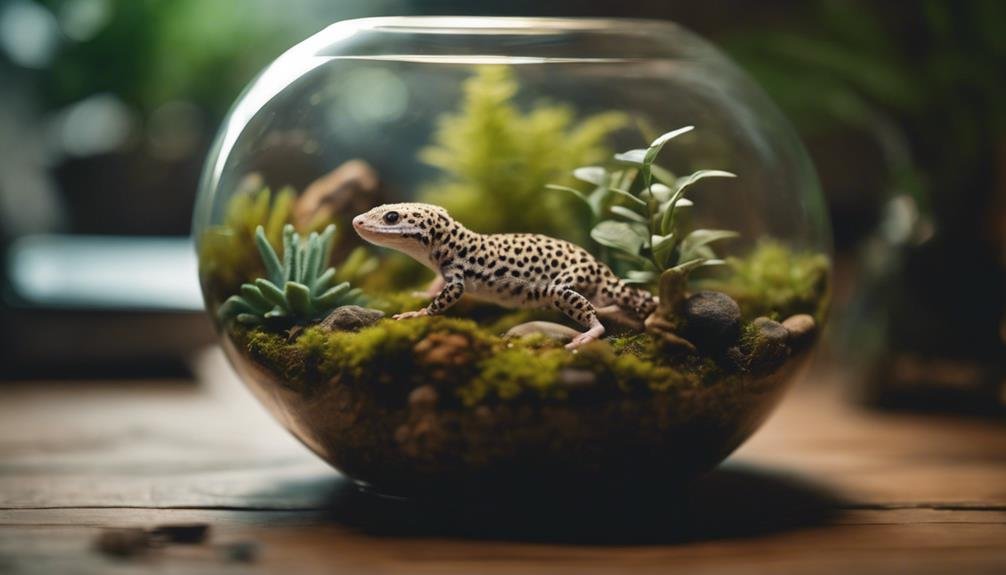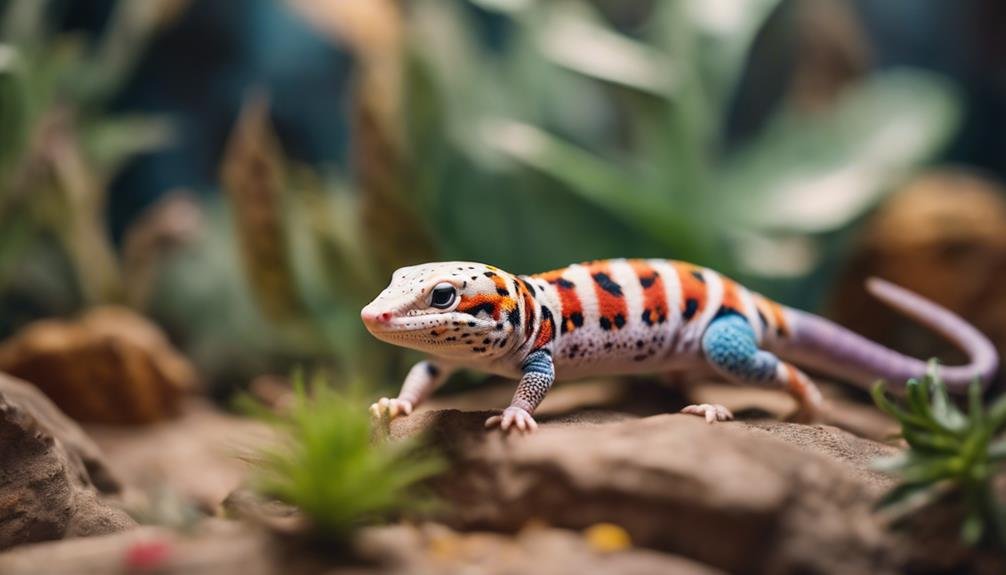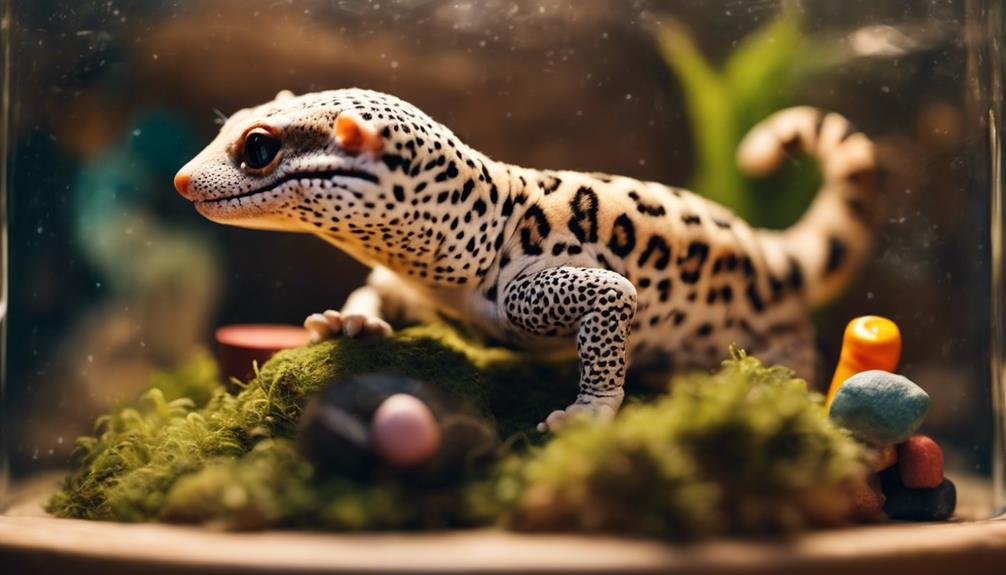You might wonder if your leopard gecko genuinely enjoys climbing or if it’s merely tolerating the climbing toys you’ve scattered around its habitat. Surprisingly, these creatures have a natural inclination towards climbing, seeking both physical exercise and mental stimulation through activities like scaling cork branches and exploring textured backgrounds. This not only mimics their natural environment but also encourages essential behaviors vital for their well-being. Additionally, their ability to drop their tails as a secret escape tool adds a fascinating layer to their climbing capabilities. This survival tactic not only highlights their adaptability but also underscores the importance of providing a habitat that challenges and engages them. Let’s explore how you can enhance your pet’s enclosure to cater to this often-overlooked aspect of their behavior, and uncover the intriguing dynamics behind their secret escape tool.
Key Takeaways
- Leopard geckos enjoy climbing on varied surfaces, providing both physical exercise and mental stimulation.
- Recommended climbing toys include cork branches and textured backgrounds to mimic their natural environment.
- Introducing climbing enrichment activities, such as commercial or DIY climbing toys, diversifies their habitat and promotes essential behaviors.
- The secret escape tool, tail dropping, allows leopard geckos to distract predators and escape, showcasing their adaptability.
- Climbing not only enhances their physical fitness but also provides vital mental stimulation, encouraging natural behaviors for their well-being.
Understanding Leopard Gecko Climbing
Delving into the world of leopard geckos, it’s clear they relish climbing on varied surfaces, from slate to cork branches, offering both a physical workout and mental joy. Unlike some gecko species, these fascinating creatures lack the toe pads that enable climbing on sheer surfaces like glass. However, this doesn’t dampen their spirit for exploration. Baby geckos, in particular, are adept climbers, turning their enclosures into playgrounds of adventure.
When you’re setting up their environment, remember that enrichment activities involving climbing must be introduced with care. The goal is to prevent any falls and injuries that could occur from overly ambitious attempts at scaling their habitat. Incorporating climbing structures not only promotes physical exercise but also provides the essential stimulation that’s vital for their well-being. By providing both horizontal and vertical spaces for these activities, you’ll enhance the overall quality of life for your leopard geckos.
It’s essential to understand that these gecko species thrive in environments that mimic their natural habitats. By acknowledging their climbing preferences and ensuring their safety, you’re offering them a sanctuary that caters to their instinctual needs and playful desires.
Top Climbing Toys for Leopard Geckos
To keep your leopard gecko’s enclosure lively and engaging, consider adding a variety of top climbing toys like cork branches and textured backgrounds. These not only cater to their climbing preferences but also mimic their natural environment, promoting essential behaviors observed in their wild counterparts. Through behavioral observations, it’s clear that leopard geckos enjoy the challenge and opportunity to explore that these toys provide, serving as an important form of exercise and mental stimulation.
When selecting climbing toys, consider both commercial and DIY options to diversify their environment. Offering a mix ensures that your gecko remains interested and physically active, helping to prevent boredom and promote overall physical fitness. These toys often double as hiding spots and basking areas, providing multiple benefits within their habitat.
However, climbing safety should always be a priority. It’s important to monitor your gecko’s habits with these toys, ensuring they’re secure and pose no risk of injury. Regular checks and adjustments based on your pet’s unique needs can create a safe, enriching climbing experience, enhancing their quality of life within the enclosure.
Setting Up a Climbing Habitat


After exploring top climbing toys for leopard geckos, it’s time to focus on how to effectively set up a climbing habitat in their enclosure. To encourage natural climbing behavior, you’ll need to provide various structures like cork branches and slate, ensuring these elements mimic their natural environment and promote habitat enrichment. It’s essential that all climbing structures are stable and securely placed; this is where climbing safety comes into play. An unstable setup can lead to accidents, detracting from the safe exploration and enjoyment of your gecko’s space.
To further enhance their climbing experience, offer a mixture of textures and heights. This variety not only keeps your gecko physically active but also mentally stimulated, addressing the important aspect of their well-being. Remember, smooth surfaces such as glass aren’t suitable for climbing, as leopard geckos lack the toe pads necessary for gripping these materials.
The Secret Escape Tool Revealed
Leopard geckos have a remarkable defense mechanism: their tails serve as a secret escape tool against predators. When they sense danger, they can perform a surprising act known as tail dropping. This self-defense tactic involves detaching their tail, which continues to wiggle and distract the predator, giving the gecko a crucial chance to flee to safety. It’s a clear demonstration of their instinctual need to survive, even at the cost of part of their body.
The regeneration process that follows is equally fascinating. Over time, a new tail grows back, although its appearance will differ from the original. This regrowth is a sign of their resilience but also a reminder that the new tail is a symbol of survival, not a perfect replacement. This phenomenon, known as caudal autotomy, isn’t unique to leopard geckos but is a widespread lizard defense mechanism. It underscores the importance of providing a stress-free environment for these creatures to minimize the likelihood of such drastic measures.
Tail dropping is their last resort, a dramatic escape strategy that showcases their incredible adaptability and will to survive.
Health Benefits of Climbing


While engaging in climbing activities, leopard geckos not only enhance their physical fitness but also experience significant cognitive and emotional benefits. This form of exercise isn’t just a way to keep your gecko active; it’s a pathway to a healthier and more satisfying life for them. By incorporating climbing into their routine, you’re offering more than just physical activity; you’re enriching their environment and encouraging natural behaviors that are essential for their well-being.
Climbing offers a host of advantages, including:
- Improved agility: Moving through different elevations and surfaces sharpens your gecko’s coordination and flexibility, making them more adept in their movements.
- Muscle engagement: The act of climbing engages multiple muscle groups, promoting stronger, healthier muscles and preventing obesity.
- Mental stimulation: Exploring and overcoming obstacles provides vital mental exercise, keeping your gecko’s mind sharp and engaged.
Is climbing an important activity for Leopard Geckos and what climbing toys are recommended for them?
Leopard gecko climbing toys are essential for keeping these pets healthy and active. Climbing is a natural behavior for leopard geckos, and providing them with appropriate toys like branches, rocks, and hammocks can help satisfy this instinct. These toys also offer mental stimulation and exercise opportunities for your gecko.
Frequently Asked Questions
Do Leopard Geckos Like to Climb on Things?
Yes, you’ll find that leopard geckos do enjoy climbing on things. It’s part of their natural instincts and plays a big role in their habitat preferences.
They’re especially fond of textured surfaces like slate and cork branches, which cater to their climbing behavior. However, you’ve got to be careful with the setup to avoid any falls.
Providing the right climbing toys can really spice up their environment and keep them happy and healthy.
Do Leopard Geckos Like to Play With Toys?
You might wonder if leopard geckos like to play with toys. Well, it’s not about toys in the usual sense but about gecko enrichment.
They’re not playful like dogs but do enjoy structures that offer sensory stimulation. Climbing items in their enclosure can trigger their natural instincts and provide both mental and physical exercise.
Why Do Geckos Try to Escape?
You might wonder why geckos try to escape their tanks. It’s often because they’re stressed, uncomfortable, or feeling threatened.
A small enclosure can make them feel trapped, lacking space to explore or hide, which is essential for these nocturnal creatures. Also, if the temperature, lighting, or humidity isn’t right, they’ll try to find a better environment.
Understanding gecko stress factors and the importance of enclosure size can help prevent escapes.
What Can I Give My Leopard Gecko to Climb On?
You can give your leopard gecko various climbing options like slate, cork branches, and textured backgrounds. Guarantee these are made from safe materials to prevent injuries.
Incorporating these into their enclosure creates a stimulating environment, offering both exercise and mental stimulation. Arrange them to enhance temperature zones, making sure your gecko can thermoregulate properly.
Also, include hiding spots within the climbing structures to mimic their natural habitat and provide security.
Conclusion
You’ve seen how leopard geckos thrive on climbing, both for fun and their health. By introducing top climbing toys into their habitat, you’re not just decorating; you’re creating a stimulating environment that mimics their natural world.
Remember, their ability to drop their tail is a fascinating escape mechanism, adding another layer to their interesting behavior. Ensuring they’ve plenty of climbing opportunities is key to their well-being, blending the perfect mix of exercise, exploration, and safety.


